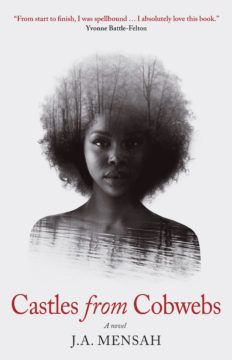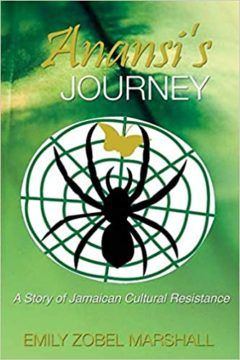by Claire Chambers
 In these dying days of summer, as I steel myself for the onslaught of an uncertain term ahead, I’ve been reading J. A. Mensah’s Castles from Cobwebs (Saraband, 2021). By way of a disclaimer I must note that J. A. – Juliana – is my colleague. However, she took up her creative writing lectureship during the pandemic, so we’ve never actually met. As preparation for getting to know each other properly I wanted to read this, her prize-winning debut novel. Castles from Cobwebs did not disappoint. I found myself devouring the book twice in quick succession, noticing different flavours with each consumption.
In these dying days of summer, as I steel myself for the onslaught of an uncertain term ahead, I’ve been reading J. A. Mensah’s Castles from Cobwebs (Saraband, 2021). By way of a disclaimer I must note that J. A. – Juliana – is my colleague. However, she took up her creative writing lectureship during the pandemic, so we’ve never actually met. As preparation for getting to know each other properly I wanted to read this, her prize-winning debut novel. Castles from Cobwebs did not disappoint. I found myself devouring the book twice in quick succession, noticing different flavours with each consumption.
Castles from Cobwebs is set in three locations – northern England, Ghana, and the United States of America. Similarly, the novel’s tripartite structure to some extent reflects the three corners of the triangular trade. Indeed, characters discuss this vicious trade as they visit a ‘castle’ in Ghana, the site in fact having been used as a fort for the imprisonment of slaves. Not only that, but the blood-soaked contours of the Black Atlantic continue to shape the lives of Mensah’s contemporary characters.
The novel’s first part, ‘Sunsum’ (loosely translated as ‘spirit’), is set in northern England. Mensah’s is a saltspray-soaked, sodden vision of Northumbria. While reading the whole novel, I regularly felt immersed in water. Seas, rivers, floods, and storms abound, probably because the triangulated locations are positioned on assorted coastlines. From first-person present tense focalization by protagonist Imani, whom we watch grow from a six-year-old girl into a young woman, we learn that one of her ways of self-identifying is as a strong swimmer. What is more, Imani has a fascination with local heroine Grace Darling. This lighthouse keeper’s daughter had saved shipwrecked people near the Farne Islands in the early nineteenth century.
The baby Imani was said to have been found lying naked and abandoned in the snow. From there she was taken by sisters into the fictional St Teresa’s Convent on Holymead Island. In its gothic strictness, the convent is reminiscent of Jane Eyre’s Lowood School. As a boarder at the convent, Imani soon becomes aware of an inchoate but unbridgeable difference between her and the nuns. Over time she comes to the cognition of her blackness, a quality which is said to have ‘a way of sneaking up on people’. Whether it is the inadvertent tortures she is put through to tame her curly hair or the assumption that she will have rhythm, her blackness is suppressed – consciously and unconsciously – in this milieu. Interpreted as her imaginary friend or a ‘demon’, Imani’s tenebrous confidant Amarie is the shadow or split self who keeps her company in Holymead’s often hostile environment. 
Imani has a human friend too, a red-faced boy with Down’s syndrome named Harold. During the internet’s early days, Harold is lucky to have access to the Yahoo search engine. For her birthday the loyal-hearted child gives Imani a list of black people who have rhythm that he has created from scraps of information found online. As the girl learns this inventory off by heart, her hunger to see herself reflected in art and life is painfully clear.
In the novel’s appropriately lyrical second part, ‘Fugue’, Imani goes to Ghana after an unexpected phone call connects her with her birth family. There she spends most of her time in the village of Dosu, but also experiences the bustling capital Accra. In Ghana Imani meets two aunts and two cousins, and for the first time in her life she is not visibly different. Instead, she is ‘surrounded by people who look like themselves in the most magnificent ways’. Imani gains confidence from no longer being othered or exposed to racism. However, she is dismayed that even some of her proud, magnificent relatives have internalized a dislike of natural hair and dark complexions.
For Imani, this trip is a quest of self-discovery in which she hopes to ‘go out and find out about my people for myself’. But her clipped English voice is very different from the LAFA or Locally Acquired Foreign Accent often spoken here, and Imani keeps on sensing her difference and discovering her complicated relationship to the feeling of belonging.
Her family are determined that Imani sees as much of Ghana as possible during her trip. In a scene alluded to earlier in this review, she visits the notorious Cape Coast Castle. She feels suffocated amid the fort’s brutal history of slavery, but is told that Ghana’s seat of government, too, is housed in a former slave castle. The continuities between the rapacious colonial past and apparently independent present are smartingly evident.
 Soon afterwards, in lively Accra, Imani watches a trapeze artist entertaining the crowds thronging a marketplace. The aerialist’s companion recounts a tale of the spider Anansi as both a warning and an encouragement to some of the people most affected by slavery’s ongoing impact. This trickster character has long been popular in West Africa, the Caribbean, and their diasporas. Anansi fables teach about using brains rather than brawn as resistance in the most difficult circumstances. While an old man tells the tale of the creature’s search for a stronger spider silk, the aerialist mimics these ‘castles knitted across the sky’, weaving a cobweb out of fabric using his trapeze.
Soon afterwards, in lively Accra, Imani watches a trapeze artist entertaining the crowds thronging a marketplace. The aerialist’s companion recounts a tale of the spider Anansi as both a warning and an encouragement to some of the people most affected by slavery’s ongoing impact. This trickster character has long been popular in West Africa, the Caribbean, and their diasporas. Anansi fables teach about using brains rather than brawn as resistance in the most difficult circumstances. While an old man tells the tale of the creature’s search for a stronger spider silk, the aerialist mimics these ‘castles knitted across the sky’, weaving a cobweb out of fabric using his trapeze.
Later in the novel, Aunt Esi will quote a letter by Raymond Carver to the effect that one should not create castles from cobwebs. Instead, so argues the American short story writer, ambitions should be built on solid ground. But Imani counters this view of cobwebs as fragile and easily torn, pointing out that the spider’s web is its home, as well as serving many other purposes.
In the short final part, ‘Book Three: Undersong’, Imani’s home shifts to New York State. Appropriately enough, given the novel’s early Brontëian overtones, Imani resides in Rochester, NY. There she reconnects with Melia, an American who had spent a few summers at the convent when they were children. It was this girl who introduced Imani to the notion that she had been adopted by Reverend Mother. An adoptee too, in the decade since their last meeting Melia has made discoveries of her own about her ancestry.
The novel then moves into the e-epistolary mode, as emails are exchanged – on Yahoo Mail, of course – between Imani and her old friend Harold back in England. And in an epilogue, Imani ties up some of the loose ends of her own delicate but homely castle from cobwebs.
What a satisfyingly rich novel this is. It is layered and well-crafted, making abundantly clear what I already know anecdotally: how much time, passion, and energy has gone into it. I recommend it as a priority for your own autumn reading list.
